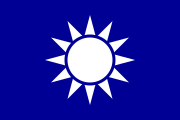Kuomintang-Nanjing
Script error: No such module "Draft topics". Script error: No such module "AfC topic". Script error: No such module "AfC submission catcheck".
 | |
| Abbreviation | KMT |
| Premier | Sun Yat-sen(Eternal) |
| Chairman | Wang Jingwei (1939-1944) Chen Gongbo (1944-1945) |
| Founded |
|
| Dissolved | 16 August 1945 |
| Split from | Kuomintang |
| Preceded by |
|
| Headquarters | Nanjing, Republic of China |
| Armed wing | Peacebuilding National Army |
| Ideology | Tridemism Fascism Pan-Asianism Chinese nationalism Anti-communism Militarism |
| Political position | Far-right[1] |
| International affiliation | Greater East Asia Co-Prosperity Sphere |
| Colours | Blue |
| Anthem | "Three Principles of the People" |
| Party flag | |
 | |
"Kuomintang-Nanjing" (traditional Chinese: 南京國民黨; simplified Chinese: 南京国民党; pinyin: Nánjīng guómíndǎng)[2], or widely referred to as the "Wang's Psuedo-Kuomintang" (traditional Chinese: 汪偽國民黨; simplified Chinese: 汪伪国民党; pinyin: Wāng wěi guómíndǎng)[3][4], officially still referred to as "Kuomintang" (traditional Chinese: 國民黨; simplified Chinese: 国民党; pinyin: Guómíndǎng); is a split of the Kuomintang (Chinese Nationalist Party) by the Chinese Collaborators in China during the Second Sino-Japanese War. Wang Jingwei's purpose on establishing this organization was to compete and distinguish itself from the Kuomintang led by Chiang Kai-shek in Chongqing. It is the sole-ruling party of Wang Jingwei's regime, and the highest organ is the Central Political Committee.
Establishment[edit]



From 28 to 30 August, 1939, Wang Jingwei secretly convened the Sixth National Congress of the Chinese Kuomintang in the city of Shanghai.[5] Wang Jingwei appointed himself and served as the temporary chairman of the conference and gave a political report on the situation of the country regarding on the Second Sino-Japanese War.[6]
The General Assembly then passed the "Resolution on Reorganizing Party Affairs" and two temporary motions, determined that all resolutions and orders of the Kuomintang under chiang in Chongqing were completely invalid, and soon elected Wang Jingwei as the chairman of the Central Executive Committee, In accordance with the purpose of "Peaceful Anti-communist Nation Building". the congress then passed the "Revision of the Chinese Kuomintang Political Platform", declare a "Decision to Anti-Communist Basic National Policy" and issued fundamental adjustment to resume sino-Japanese diplomatic relations.[1][6]
On 30 March, 1940, Wang Jingwei attend the "National Government Capital Returning Ceremony" and established a puppet government in Nanjing, the state was named; "the Reorganized National Government of the Republic of China". [5] Wang served as the President of the Executive Yuan and Chairman of the National Government (Chinese: 行政院長兼國民政府主席). He issued the "Ten Political Platforms for Peaceful Nation Building". which by this time, The Kuomintang was the only legal sole-ruling party in the regime.[5] it ruled the country directly under Wang Jingwei, essentially a one-party dictatorship. and nominally participated in the management of the North China Political Affairs Committee and the Mengjiang United Autonomous Government.[7]
Leadership[edit]
At the beginning of its establishment, the Kuomintang-Nanjing still recognizes Lin sen, who is appointed by Chiang Kai-shek in Chongqing as the chairman of the National Government.[8] However Wang Jingwei appointed himself as the "acting chairman", concurrently serving as the chief executive and chairman of the Standing Committee of the Central Executive Committee.[6]
On 10 November 1944, Wang Jingwei died in Nagoya.[9] On 12 November, the Nanjing "Central Political Committee" held an emergency meeting and decided that Chen Gongbo will be the president of the Executive Committee, acting chairman of the National Government, and chairman of the military committee.[10] Chen officially took office on 20 November. When he took office, Chen Gongbo stated that he would adhere to the policy set by Wang Jingwei and would not waver no matter how the war progresses or how urgent the current situation is.[10] Following Chen Gongbo, Zhou Fohai became the mayor of Shanghai in January 1945.[10][6]
Disbandment[edit]
On 15 August 1945, Japan finally surrendered, and on 16 August, at 4 pm, Chen Gongbo and Zhou Fohai held an interim meeting of the Central Political Committee in Nanjing, announcing the abolition of the Reorganized National Government and all of its institutions including the party.
References[edit]
- ↑ 1.0 1.1 "一、汪伪中国国民党党部" (in 中文). Retrieved 2021-04-10.
- ↑ "汪偽檔案" (in 中文). Retrieved 2021-04-10.
- ↑ "真實的汪精衛 - 國立中央大學數學系" (PDF). Retrieved 2021-04-10.
- ↑ "汪墓砌建、炸毁始末" (in 中文). Retrieved 2021-04-10.
- ↑ 5.0 5.1 5.2 高雲昉 (1994). "汪偽國民黨"六大"". Archived from the original on 2019-05-13. Retrieved 2018-03-14.
- ↑ 6.0 6.1 6.2 6.3 陳大為. 楊甯, ed. 汪精衛大傳 (第1版 (2010年5月1日) ed.). 中國北京: 華文出版社. p. 855. ISBN 9787507531114. Search this book on

- ↑ George F. Botjer (1979). A short history of Nationalist China, 1919–1949. Putnam. p. 180. ISBN 9780399123825. Search this book on

- ↑ George F. Botjer (1979). A short history of Nationalist China, 1919–1949. Putnam. p. 136. ISBN 9780399123825. Search this book on

- ↑ "From Traitor To Martyr: Drawing Lessons From The Death And Burial Of Wang Jingwei, 1944". Journal of Chinese History 中國歷史學刊. 3 (1): 137-158. January 2019. doi:10.1017/jch.2017.43.
- ↑ 10.0 10.1 10.2 蔡德金. 《江蘇文史資料選輯》第二十九輯. Search this book on

This article "Kuomintang-Nanjing" is from Wikipedia. The list of its authors can be seen in its historical and/or the page Edithistory:Kuomintang-Nanjing. Articles copied from Draft Namespace on Wikipedia could be seen on the Draft Namespace of Wikipedia and not main one.
